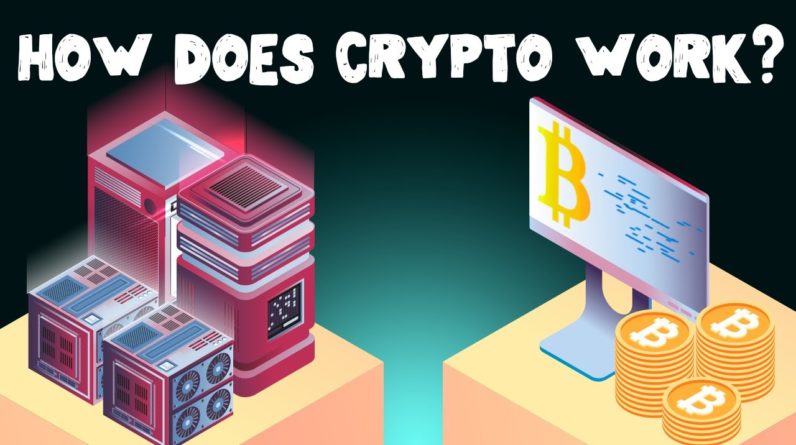
Hey, in this video, I’m going to tell
you how does cryptocurrency work! Nowadays, cryptocurrencies seem to be all
around us – we trade crypto, transact in crypto, send it to our friends and relatives, buy
and sell goods and services for crypto, and can even borrow and lend it out, too! As we perform all of those processes, though,
do you ever think about what’s going on in the background? I’ll let you in on a little
secret – there’s a lot of stuff happening, with every single transaction! So, then – let’s
figure out how cryptocurrencies ACTUALLY work! Before that, though, I’d like to welcome
you to Crypto Finally Explained – the most crypto-friendly educational YouTube
channel for *actually* learning crypto! Here, I finally explain crypto topics using
simple animations, visual doodles, and real-life examples, so no matter if you’re five,
or seventy-five, you’ll be able to understand it! In this video, we’re going to dive deep into
the question of how does cryptocurrency work. Specifically, we’ll explore what makes
cryptocurrencies unique, what happens during a transaction, and why these questions are something
you should even care about, in the first place.
Let’s get to it! In order to really get a grasp on what is
cryptocurrency and how does it work, you need to first understand the underlying technology
that crypto is built upon – blockchains. This is, evidently, something that I’ve explored thoroughly
in a separate video. If you still haven’t watched it, do so – it will help you get a better
understanding of what we’re talking about today! That being said, for the context of
this video, we’ll focus on one of the key functions of blockchain technology
– automated and immutable bookkeeping. You see, a blockchain is simply a huge
digital database. You can think about it as multiple boxes, being connected
by a single chronological chain. Each box holds information about
the transactions that you perform, and the chain helps with keeping everything
organized and, well… Chronological! This is the very first thing that makes
cryptocurrencies unique – the fact that each cryptocurrency is based on a blockchain, and that
all transactions that involve cryptocurrencies are recorded on the said blockchain, too. For a visual
example, you can imagine it as a bank – every money transfer and credit card transaction
that you make is recorded by your bank! Now, admittedly, cryptocurrencies and crypto
transactions are widely considered to be an improvement over traditional banking institutions,
and default money transferring methods.
One of the biggest reasons why that’s the case is just
that – transparent and immutable bookkeeping. Traditional banks can run into a wide array of
troubles, when it comes to managing the personal information of their customers. Data breaches,
power outages, and good, old-fashioned human error are just a few things that can go wrong! With
blockchains generally being completely transparent and decentralized, all of these aforementioned
issues are, admittedly, non-threatening. Then, there’s the anonymity aspect, too. With your
traditional banking institutions, anonymity is out of the question – you have to identify yourself,
be transparent about where your money is coming from, who you’re sending your money to, and so on.
So, if you have a friend named Tim, and want to send him some money, you’ll need to tell the bank
WHY you’re sending your money to Tim, as well as make sure that Tim isn’t a suspicious individual
who would be involved in some shady business.
Haha, now, sure, that’s an exaggeration, but
you get the idea – with traditional banks, everything is pretty strict, in this regard.
With crypto, though, it’s somewhat the opposite – the same blockchain technology behind
cryptocurrencies aims to preserve your anonymity! Specifically, this is done with
the help of cryptocurrency wallets. Each wallet has a unique code associated with
it – it’s called a “public wallet address”. When you transact with crypto, while
all of the information is stored on the blockchain and is public for everyone
to see, all that anyone will see is your wallet address sending an X amount of
cryptocurrency to Tim’s wallet address.
In other words, no one will know that
it’s YOU sending the crypto to TIM. One last point that I’d like to stress, when
it comes to cryptocurrencies and how they work, is the fact that there are multiple different
crypto projects, as well as blockchains out there. Each of these crypto projects have their own, special functions, and many of them
have very unique working models, too. That is to say – in this video, we’re focusing
on the general aspects of how does crypto work, from the perspective of
cryptocurrency transactions. If there’s a specific crypto project that you'd
like to learn about, though, make sure to leave a comment in the comment section, below – I
might consider making a dedicated video on it! That’s the general gist of things, as far as
the unique features of crypto technology are concerned. As you might expect, there’s a lot more
to cover, in this regard, but as I’ve mentioned earlier, it’s something for a different video,
altogether. So, if you’re not familiar with any of the concepts that we’ve discussed, up to this
point in the video, check out my channel – I have an entire catalog of videos covering each
and every single of those topics, in-depth! Now that you’re familiar with the unique
features of cryptocurrencies, in general, it’s time to check out how does crypto
work, transaction-wise – specifically, what happens when you perform a cryptocurrency
transaction.
For consistency’s sake, let’s stick to the same example I gave earlier
in the video – you sending some crypto to Tim. Also, let’s say that you’ve decided
to send Bitcoin to Tim – evidently, this would work the same with most
other cryptocurrencies out there, but Bitcoin is probably
still the simplest example. So, in order to perform this transaction, you
will need to have a cryptocurrency wallet, with BTC inside of it. Most wallets work the
same – you enter the receiver wallet address, the amount of crypto that you’d like
to send, and pass a few confirmations.

Now, as soon as you send that BTC, your
transaction will be submitted to the network. In the case of Bitcoin, it will need to
be verified, in order to be confirmed. This is the core security measure that’s
employed by blockchain technology – it’s called a “consensus algorithm”, and it helps keep the
cryptocurrency network secure and fraud-resistant. It’s a really intimidating-sounding
term, but what it boils down to is a method of how the blockchain confirms the
validity of a transaction. Different blockchains use different methods, and with Bitcoin, the
consensus algorithm is called “Proof-of-Work”. Have you ever heard the term
“cryptocurrency miner”? Well, this is what Proof-of-Work refers to –
miners are people who employ their computers (or other special devices) to earn cryptocurrency
for them! Miners earn crypto for confirming transactions happening on the blockchain – such as
your transaction, where you send Tim your Bitcoin.
As you might imagine, this is an entire, huge
topic, in of its own! For now, though, just keep in mind what I said earlier – when you perform
the transaction, it’s placed in a queue, on the blockchain, and awaits confirmation. Now, if your
transaction is legitimate, it will receive all of the required confirmations, and the Bitcoin that
you’ve sent will reach Tim’s wallet in no time. On the flip side, if you decide to
“trick the system”, and try to perform some sort of a hacker-like faulty
transaction, it will get denied, pretty fast – that’s the magic of consensus
algorithms and blockchain security! You should be aware of this entire process
if you’re looking at how does investing in cryptocurrency work, as well. As you purchase
crypto, or perform any other transactions, many of those processes will
be happening in the background! All of that being said, that’s essentially
how crypto transactions work! Mind you, as we’ve established earlier, each cryptocurrency
is going to have this process look a bit different from the other, especially nowadays, with so many
new blockchain projects constantly springing up, all around.
The premise, though,
will remain the same, either way! So, then – now that you have a general idea
of how cryptocurrencies work, it’s also worth addressing the “why” – specifically, why it’s
important to know this, in the first place! Naturally, since you’re watching this video, you
do probably already have some reasons of your own. However, the point that I want to
emphasize is that EVERYONE should learn about crypto – how it works, what
happens during transactions, and so on. The biggest reason for why that’s the case is
pretty simple, actually – with crypto becoming as popular as it is, it’s also being integrated into
our everyday lives, too! While the integrations are still very slow, I urge you to think about
it – the simplest example would be major payment gateways, such as PayPal and Visa starting to
accept and perform cryptocurrency transfers.
Following that, if you understand how
cryptocurrencies work, you will also have a much better chance of protecting yourself
from potential scams and hacking attempts. No malicious individual or organization
will be able to come in and trick you, since you will already understand the differences
between a normal cryptocurrency transaction, and some shady dealing happening in the background. Lastly, learning about how cryptocurrencies
work is also one of the very first steps that you can take when it comes to
studying the crypto world, as a whole! Cryptocurrencies, and the blockchain
technology behind them, are some of the core, essential elements that
make up the entire industry. This is very true if you want to look into how
does the crypto market work, or even how does investing in cryptocurrency work, as well! When
you understand the technology behind crypto, and what happens during transactions, you’ll be much
better-equipped to start your investment journey! All that you need to do in order to understand the
importance of crypto tech is take a look at DeFi, or decentralized finance.
It’s a new-and-emerging
form of finance, and one that already houses some huge investors, and incredible amounts of money.
Well, no matter if it’s a cryptocurrency lending platform, a gambling game based on blockchain
technology, or some sort of a wallet project, everything essentially boils down to the very
fundamentals of how cryptocurrencies work! I sincerely hope that, after watching this video
on how does cryptocurrency work for dummies, you can now proudly say that
you know how crypto works, especially when it comes to
crypto transactions and transfers. If, while watching the video, you’ve come across
some terms or concepts that sound alien to you, please make sure to check out my channel – on it, you will find videos on all
of the topics mentioned today! Don’t forget to subscribe, too, so that you
wouldn’t miss out on any future uploads! All of that being said, thanks for watching,
and I really hope to see you in my next video!




